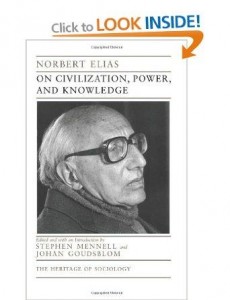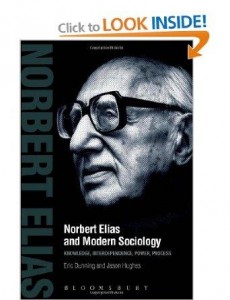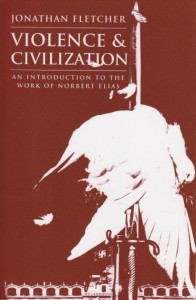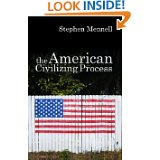Thinking with Norbert Elias: the ideas framework of the WWW project
Please reference as: Whites Writing Whiteness (2018) ‘Thinking with Norbert Elias: the ideas framework of the WWW project’ Whites Writing Whiteness www.whiteswritingwhiteness.ed.ac.uk/overviews/thinking-with-elias and provide the paragraph number as appropriate when quoting.
1. What has the work of the sociologist Norbert Elias (1897-1990) to do with a project on Whites Writing Whiteness? German by birth, Elias lived in Britain from the 1930s on for many years and then later in Holland; during his British years, he became an increasingly important sociological presence and was based at the University of Leicester. As a social theorist, he is notable, indeed fairly exceptional, for theorising around grounded historically-focused pieces of practical research inquiry, with these concerning such things as the ‘civilizing process’ of how societies change, court society in France, the development of Germany as a state, alongside more ground topics such as football, dying and death and the character of community, among others. Given these interests, his work might as a result be seen – mistakenly – to be not particularly relevant for the WWW project. But in fact it has many helpful synergies, synergies that are highlighted by a number of helpful books on the Elias corpus of ideas, which together add up to an excellent introduction to Elias’s thinking. Readers who are unfamiliar with Elias’s work are recommend it to them, and some of the interesting aspects of their contents are sketched out in what follows. A brief discussion of the books is followed by Setting out the reasons why ‘thinking with Elias’ has been a powerful influence on WWW research.
2. The first book for discussion is a collection of Elias’s writings edited by Stephen Mennell and Johan Goudsblom, On Civilization, Power and Knowledge. Its contents cover a broad sweep of Elias’s interests and provide the best introduction to his work in his own words that is currently available. It provides a helpful and readable overview in selections from Elias himself, in which his engagingly urbane and humane voice comes through strongly.
3. Stephen Mennell and Johan Goudsblom (1998) On Civilization, Power and Knowledge Chicago: University of Chicago Press. Readers will find the sections of Mennell and Goudsblom’s reader on ‘The social constraint towards self-constraint’, ‘Diminishing contrasts, increasing varieties’, ‘On the monopoly mechanism’, ‘The decline of the state monopoly of violence in the Weimar Republic’ and ‘Homo Clausus: the thinking statues’, particularly helpful in conveying the breath of Elias’s concerns.
Readers will find the sections of Mennell and Goudsblom’s reader on ‘The social constraint towards self-constraint’, ‘Diminishing contrasts, increasing varieties’, ‘On the monopoly mechanism’, ‘The decline of the state monopoly of violence in the Weimar Republic’ and ‘Homo Clausus: the thinking statues’, particularly helpful in conveying the breath of Elias’s concerns.
4. There are quite a few interesting textbook-style overviews of Elias’s work, such as Robert van Krieken (1998, Norbert Elias London: Routledge), Stephen Mennell (1989, Norbert Elias: An Introduction Oxford: Blackwell) and Dennis Smith (2001, Norbert Elias and Modern Social Theory London: Sage) among others. There has, however, been surprisingly little engagement with Elias’s work to date with regard to gender matters or by feminist sociologists, although he was usually enlightened and responsive in such terms. These overviews are helpful and to varying degrees give insight into the project Elias was engaged in, but none of them has fully succeeded in conveying the core of his ideas and approach until the 2013 publication of a truly excellent exposition of Eliasian thinking by Eric Dunning and Jason Hughes, Norbert Elias and Modern Sociology, which brings home just how fundamental a challenge to mainstream sociological work Elias makes.
5. Eric Dunning and Jason Hughes (2013) Norbert Elias and Modern Sociology. London: Bloomsbury. Both Dunning and Hughes hail from the University of Leicester and  donning was formerly a colleague of Elias. However, it is the depth of their thoughtful intellectual engagement, rather than collegial links, that gives their book its power and reach. Its chapters on the basic concepts of figurational sociology (2), Elias’s central theory (3) and on ‘Elias and ‘the habits of good sociology’ (6) are particularly insightful, although the whole book is important reading and extremely well written to boot. The last mentioned chapter, ‘Elias and “the habits of good sociology”’ among other things provides an in-depth engagement with similarities and differences between the Eliasian project and the oeuvre of Anthony Giddens, Michel Foucault and Pierre Bourdieu. This is the best discussion of Elias’s work that has appeared to date.
donning was formerly a colleague of Elias. However, it is the depth of their thoughtful intellectual engagement, rather than collegial links, that gives their book its power and reach. Its chapters on the basic concepts of figurational sociology (2), Elias’s central theory (3) and on ‘Elias and ‘the habits of good sociology’ (6) are particularly insightful, although the whole book is important reading and extremely well written to boot. The last mentioned chapter, ‘Elias and “the habits of good sociology”’ among other things provides an in-depth engagement with similarities and differences between the Eliasian project and the oeuvre of Anthony Giddens, Michel Foucault and Pierre Bourdieu. This is the best discussion of Elias’s work that has appeared to date.
6. Elias is particularly associated with his early (1930s) work on the ‘civilizing process’, in which he examined the long-term gradual processes of change in Germany, France and Britain, doing so by exploring such things as manners and morals as invoked in etiquette books and manuals. Indeed, he is often misunderstood in relation to this, by readers reacting to their presumption of what ‘civilizing’ means, treating it as though Elias has a naive Whiggish ‘onwards and upwards’ progress view of societal level changes. In fact, for Elias the term has an ironic inflection and he fully recognises that violence, force and decivilizing processes are also constitutive. But what he is interested in is how what is supposedly ‘civilised’ is understood and enacted in particular times and places. This aspect of his work is written about interestingly by Dunning and Hughes. However, such matters are the core focus of the third book considered here, Jonathan Fletcher’s Violence & Civilization: An Introduction to the Work of Norbert Elias.
7. Jonathan Fletcher (1997) Violence & Civilization: An Introduction to the Work of Norbert Elias Cambridge: Polity Press. Fletcher’s Violence and Civilization starts from  the premise that Elias’s work concerned with violence and the state monopolisation of (deemed to be legitimate) force is fundamental to his thinking. It explores this across a range of work but in particular regarding his later The Germans (1989/1996) as well the much earlier The Civilizing Process (1938/2000 edition), and also regarding everyday forms of contained or ritualised violence such as in competitive sport and fox hunting. Fletcher’s discussion joins up ideas about de/civilizing processes, state formation, identity and violence with another distinctively Eliasian concept, that of habitus. Although now associated with Bourdieu (who was influenced by Elias), the concept of habitus was in fact used and developed by Elias and others some decades before, and in the context of a more general contemporary engagement with the idea, with his discussion long predating the more static and conventional Bourdieu version.
the premise that Elias’s work concerned with violence and the state monopolisation of (deemed to be legitimate) force is fundamental to his thinking. It explores this across a range of work but in particular regarding his later The Germans (1989/1996) as well the much earlier The Civilizing Process (1938/2000 edition), and also regarding everyday forms of contained or ritualised violence such as in competitive sport and fox hunting. Fletcher’s discussion joins up ideas about de/civilizing processes, state formation, identity and violence with another distinctively Eliasian concept, that of habitus. Although now associated with Bourdieu (who was influenced by Elias), the concept of habitus was in fact used and developed by Elias and others some decades before, and in the context of a more general contemporary engagement with the idea, with his discussion long predating the more static and conventional Bourdieu version.
8. These books each provide interesting and helpful discussions and considerably add to the exposition of Elias’s ideas. However, a full-blown articulation of the corpus of Elias’s ideas, although in a different context from Elias’s own comparative engagement with Germany, France and Britain, is a far more stretching test of their workability. This is provided by Stephen Mennell’s (2007) The American Civilizing Process, a considerable achievement in coming to grips in just 320 pages with a society so large and complex and which has gone through so much change over time as the United States.
9. Stephen Mennell (2007) The American Civilizing Process Cambridge: Polity Press. Rather than a digest of Elias’s thinking (Mennell and Goudsblom), a thoughtful exegesis (Dunning  & Hughes), or an insightful move sideways (Fletcher), Mennell’s The American Civilizing Process meets Eliasian ideas full on, providing a detailed and grounded examination of how they shape up in exploring and interrogating the long-term trejectors of the US.
& Hughes), or an insightful move sideways (Fletcher), Mennell’s The American Civilizing Process meets Eliasian ideas full on, providing a detailed and grounded examination of how they shape up in exploring and interrogating the long-term trejectors of the US.
10. Starting close to the central core of Elias’s ideas, Mennell’s investigations over the course of the book become increasingly engrossed with the specificities and details of American history and change. Chapters deal with, for example, ‘fellow Americans and outsiders’, manners, elites and aristocracies, the market, violence, wilderness and the frontier, integration and urbanization, the ‘American Dream’, religion and notions of an ‘American social character’. American specialists are likely welcome Mennell’s increasing shift of emphasis across the book from Elias onto the detail, and certainly for teaching purposes this is an excellent overview. However, for those more interested it how Elias’s ideas shape up in the different context of the US as compared with Germany, France and Britain, there are losses. HIs changing emphasis can be seen in Eliasian terms as a decision to focus on the increasing varieties; but what as a result is backgrounded is a fuller consideration of the dynamics of the established and the outsiders in relation to gender and race and their intersections. But nonetheless, this book is a considerable (in both sense of the word) achievement and one to be returned to and engaged with.
11. The connections between Norbert Elias’s work and the WWW project research is in practice deeper than the word ‘connections’ will convey. In fact the broad approach and ideas framework of WWW draws in depth on his thinking and adds up to being an Eliasian one. It is however one of a rather unconventional kind because it involves ‘thinking with’ rather than trying to apply his ideas .
12. The WWW project is concerned – as is Eliasian sociology overall – with the detailed ‘how’ of social change, the ‘how’ of its happenings and possible variations in this over time between differently situated people, including regarding the differences of gender, age, place, generation and ‘race’, and also of changes over time. It explores this ‘how’ of social change specifically in the South Africa context and over the longer term. And given the constitutive character that ‘race’ in the sense of skin colour has taken in South Africa’s economy and polity over the period of its colonisation, habitation and for a lengthy period its rule by white people, WWW focuses on changes concerning ethnicity and ‘race’ as its means of grappling with change in South Africa more broadly.
13. WWW research investigates whiteness as this developed over the lengthy time-period from the 1770s (the arrival of missionaries and other Europeans in numbers and the institution of the colonial states) through to the 1970s (the aftermaths of Sharpeville in 1960 followed by Soweto in 1976) and the resultant changes and possible continuities in how white people in South Africa over this time saw themselves and ‘others’ in the society around them. It does so by researching letters and correspondences in letter-writing collections, in which flows of letters were written over many generations, because these provide truly longitudinal data of the kind essential in order to address ‘how’ questions. It analyses how whiteness and its ‘Others’ is represented in letters over time and regarding how the moral and political order of ‘race’ has been shaped and re-shaped and re-represented over time in letter-writing practices. In addition, it recognises and confronts the representational problematic involved, that there is not a straight-forwardly referential relationship between letters and lives, although there are important points of interconnection, albeit ones which are complex and tricky in character.
14. For Elias, society is always in media res, it is always in process, and for every point of apparent beginning to social events and circumstances some yet further antecedent ones can be traced. ‘Sociogenesis’ is Elias’s term for this perpetual becoming of the social order, it is fundamental to his entire concept of what society ‘is’ and therefore the core of what sociology as a discipline for him should be concerned with. In the South African context, social change and changes concerning ‘race’ within this – the central concerns of WWW – are indicative of sociogenesis. Sociology has a fortunate central subject-matter, one which never runs out or runs dry, for social change has no beginning, no end; and while an argument can be made that ‘race’ in its present incarnation is a fairly late-comer on the social scene, distinguishing and ranking people by constructions of ethnicity and the connotations attributed to skin colour are not, although they have certainly taken on different meanings and evaluations over time.
15. Relatedly, Elias emphasises that terms like ‘individual’ and ‘society’ and related binaries are ones that reify. That is, they solidify and simplify the much more complex reality of people as social beings and always in unfolding relationships with others, with society being composed by complicated arrangements of people in constant interrelationship with others. A key means of recognising and analytically getting to grips with the intertwined character of individual and society, and consequently agency and structure and related pairings, is provided by Elias’s concept of ‘figuration’. He explains this by drawing an analogy with a dance. A dance can be a tango, a war dance, rock ‘n roll and so on, but remains a dance; individual dancers may join in, sit out, re-engage or leave, while the dance continues; and although ‘a dance’ has a structure-and-process that is independent of any one dancer, it is not independent of there being people as a collectivity engaging in dancing.
16. The concept of figuration when thought about through its analogy with a dance captures the essential character of letter collections, the core data for the WWW project. These archive collections are distinctive in containing flows of letters written over long periods of time (for some collections, from the 1790s to the 1950s) and so they constitute a figuration with lasting structural features. One of these is that, as with a dance, none of the original letter-writers from the start of the collection are still writing at the end, but with a large number of people (it can be some hundreds) joining, participating in and then for a variety of reasons ceasing to contribute letters to it.
17. The idea with which Elias is most often associated is that of ‘the civilizing process’. In his use of the term, as noted earlier, this is no Whig notion of development in the sense of progress or betterment. Instead in a number of important publications and most notably The Civilizing Process (1939/2000 edition) and The Germans (1989/1996), he grapples with the complicated, sometimes backwards and sometimes forwards ‘fits and spurts’ character of change in particular societies. In The Civilizing Process, this concerns France, Germany and Britain over the longue durée from the Middle Ages to the middle 1930s, when the book was first published. In The Germans, Elias is particularly concern with the National Socialist or Nazi state as heralding a marked ‘decivilizing’ period in the history of German society, while at the same time he also recognises that at different time-periods (after, as well as before) it has had different defining characteristics. Moreover, the operations of power and force are neither tangential to nor necessarily ‘uncivilized’ within Elias’s framework, which recognises states as entities concerned with the monopolization of legitimate force, and also that states can be experienced as illegitimate as well as legitimate.
18. This idea that states and whole societies can have ‘civilizing’ trajectories which may include contrary and very ‘uncivilised’ phases, or go through oscillations in this respect, is particularly helpful in making sense of the overall character in change in South Africa. This includes the role of the four colonial states (the Cape, Free State, Natal and the Transvaal or South African Republic) and then the Union national state from 1910 on, and also the pervading sense from the research data WWW is concerned with that in ‘race’ terms what was happening on the ground at different times, in particular areas, involving a range of people of different backgrounds, beliefs and social practices, was to different degrees out of synch with this state level. The WWW take on this is that civilizing, decivilising and recivilizing processes all contributed and that their varied forms need careful examination in a figurational way in its research.
19. In addition, Elias’s ideas about the established and the outsiders and how the established achieve and maintain this status along with a tightly maintained habitus are particularly important for thinking about South Africa. How did such a small number of whites manage over time to achieve control over a much larger number of black people? Insofar as an ‘answer’ can be provided, this is that it happened day by day and in a multiplicity of ways that added up and, in various times, places and circumstances and with backwards and forwards movements, achieved structural force.
20. Elias’s style of thinking and theorising poses challenges for social scientists reared on a diet of conventional binaries – thinking with Elias, structure v. action, individual v. society, realist v. idealist, and theory conceived in the abstract, all bite the dust. These have to be given up. What is gained in return is more interesting and much more exciting – it is the possibility and the actuality of joined up sociological thinking about how societies and peoples live and change over time. Elias’s approach to this is a more discursive one that than has beenadopted in the WWW project, but the lineage is clear and lies in WWW’s use of the broad interconnected sets of Elias’s ideas sketched above concerning sociogenesis, figuration, the de/civilizing process, the established and the outsiders and their habitus.
21. Overall, the WWW project is operationalising key Eliasian ideas because these provide an insightful and important way of bridging theory, methodology and substantive inquiries, including the comparative aspects of these. Elias’s thinking was honed around comparisons between Germany, France and Britain. Stephen Mennell has extended this to the rather different case of the US. The crucial question in WWW terms is, in what ways, to what extent, with what exceptions and reservations, does it shape up when confronted with South Africa? This is the topic explored in the range of ‘thinking with’ Elias essays.
Last updated: 13 May 2021





